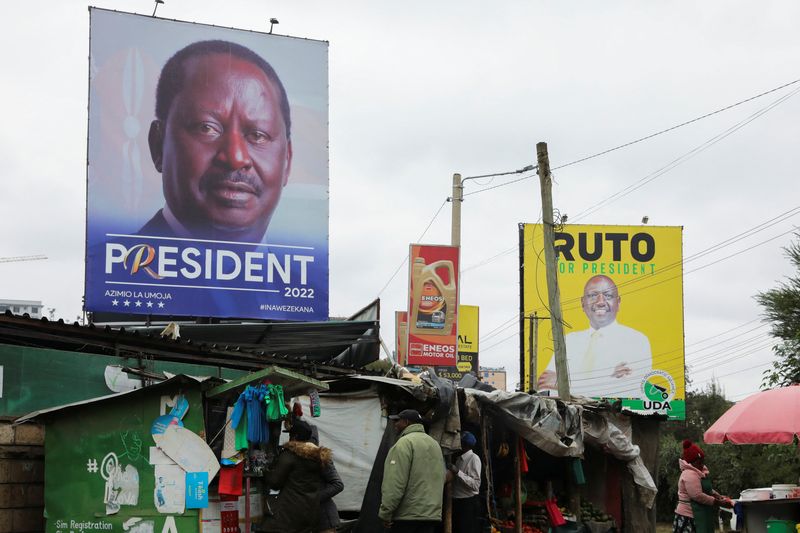By Duncan Miriri and Karin Strohecker
NAIROBI (Reuters) - Millions of Kenyans will head to the polls on Tuesday to pick a new president in a fiercely contested election that pitches veteran opposition leader Raila Odinga against Deputy President William Ruto.
President Uhuru Kenyatta is not running due to term limits but is backing Odinga. Lawmakers and country officials will also be elected.
The final four opinion polls published last week put Odinga ahead with a margin of 6-8 points but Ruto has dismissed them as fake and designed to sway the electorate.
Following are key topics for investors:
WHAT IS AT STAKE FOR INVESTORS?
One of the most advanced economies in Africa, Kenya is a commercial hub for East and Central Africa, hosting regional headquarters of global firms like Alphabet (NASDAQ:GOOGL) and Visa (NYSE:V).
Its stocks, bonds and the shilling currency are some of the most traded by foreign investors on the continent.
A number of flashpoints are on investors' radar for the election. Deadly violence erupted after recent elections with more than 1,200 people killed after the 2007 ballot.
The global backdrop looks also challenging: Kenya, an energy importer, has felt the pinch from elevated crude oil prices. Like other emerging economies, Kenya faces rising borrowing costs as the U.S. Federal Reserve and other major central banks hike interest rates to tame inflation.
Spreads of Kenya's hard-currency debt over safe-haven U.S. Treasuries - the premium demanded by investors - have come down from over 1,400 basis points in mid-July, but are still in the danger zone of above 1,000 bps.
WHAT ARE MARKETS WATCHING OUT FOR?
Markets are closely scrutinising fiscal accounts, the balance of payments and central bank reserves. Having a current account deficit as well as a fiscal deficit, Kenya's financial position has been a longstanding source of vulnerability.
"Fiscal consolidation is going to be paramount for the elected president," William Blair fund manager Yvette Babb told Reuters.
Gergely Urmossy, emerging market strategist at Societe Generale (OTC:SCGLY), said a credible strategy could see Kenya regain full access to international capital markets, while a good relationship with the International Monetary Fund was key.
"Kenya's next president will need to present a credible and responsible macro-financial stabilisation agenda, which addresses the wide twin deficit and promotes debt sustainability," said Urmossy.
The IMF agreed a three-year, $2.34 billion extended fund facility and extended credit facility in April 2021. During its latest review the fund said Nairobi was on track to meet most of the program's objectives, though urged authorities to stick to the agreed fiscal consolidation path.
Committing to structural reforms was "essential to meet the IMF's requirements in terms of unlocking further tranches and also strengthening the market's confidence that the new government is both willing and able to deliver," Urmossy added.
WHAT IS THE DIFFERENCE BETWEEN ODINGA AND RUTO?
Pledges between the two key candidates differ on key policy priorities such as tackling debt issues, job creation and social spending.
Odinga has pledged to renegotiate debt terms to lengthen maturities and free up cash for social interventions and development.
That aim of rearranging debt to lengthen maturities could be targeted at domestic debt servicing, said Sthembiso E Nkalanga at JPMorgan (NYSE:JPM), which has been higher than servicing of foreign debt.
Ruto pledges to reduce borrowing and stimulate small enterprises to help drive growth and generate revenues.
"Ruto recognizes the country's debt problem, but envisions raising economic growth and broadening the tax base would suffice in restoring creditworthiness and ensuring fiscal prudence," Nkalanga said.
Both broadly converge on the Big 4 Agenda - Kenya's 2030 blueprint which divides the country's future economic development into four pillars: Food security, affordable housing, manufacturing and affordable healthcare.
WHAT DO LOCAL INVESTORS THINK?
Odinga and Ruto have offered differing visions for the economy, with Odinga advocating for enhanced social protections, and Ruto promising to empower small enterprises.
Local investors are optimistic: Three quarters of all business executives who took part in the central bank's July market perception survey said they were optimistic, compared with just a third in the same survey five years ago.
This is due to outgoing President Kenyatta making peace with arch rival Odinga in March 2018 in the wake of a divisive election contest, which led to political stability.

"We have never had a more peaceful time, days to the election. The country is calm," said Joe Mucheru, the minister for information and communication.
However, a new schism opened between Kenyatta and his estranged deputy Ruto, who Kenyatta says is not fit to be president. Meanwhile, the government has deployed extra police in areas of the Rift Valley, Ruto's political power base and police say they are prepared for any opportunistic looting in major cities like Kisumu during and after the election.